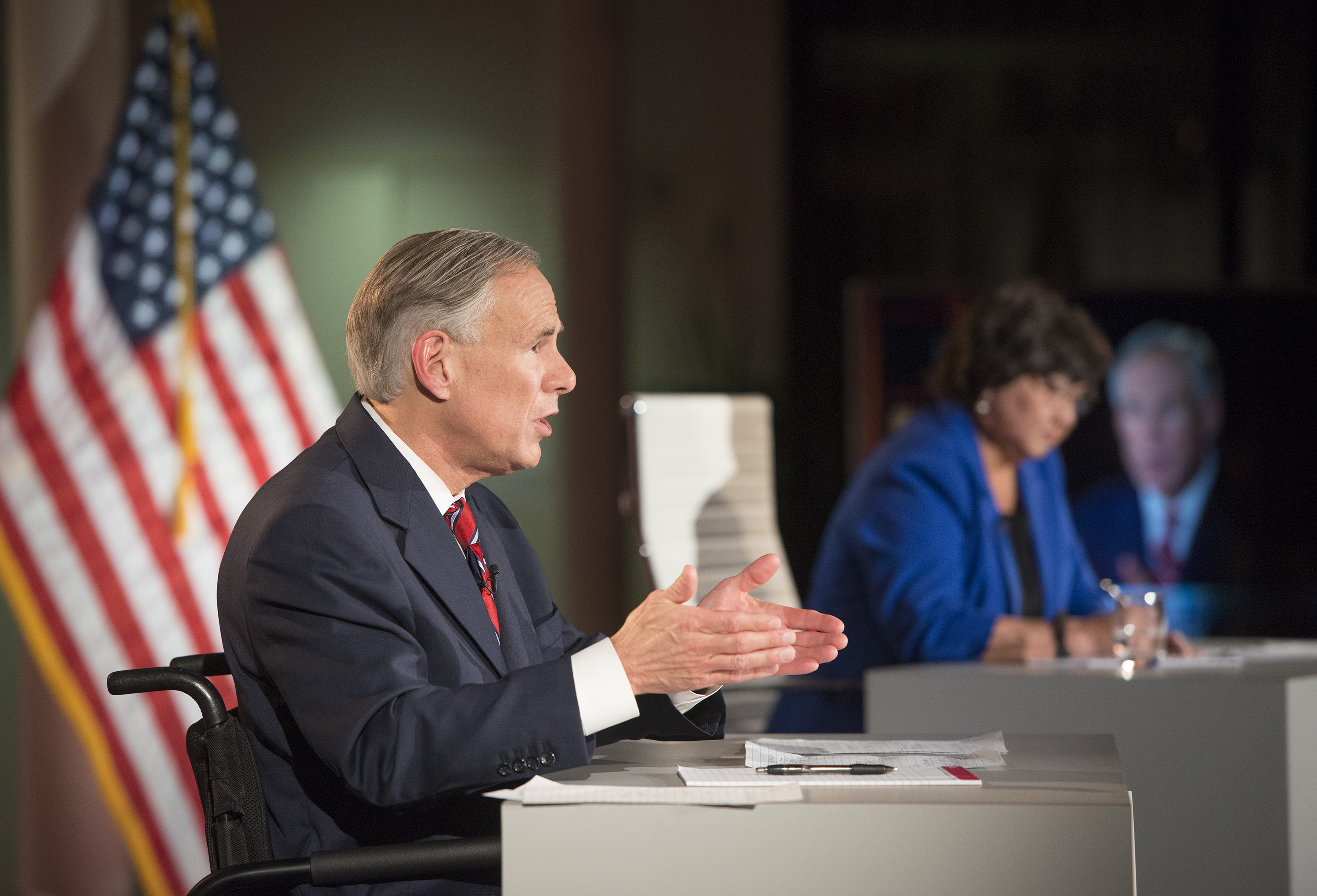Texas 2020 Elections: Preparations and Considerations
Texas faces some unique challenges to holding successful elections amid the pandemic. These include legal uncertainty and the potential for overwhelming in-person voter turnout made worse by inadequate poll worker staffing.

Published by The Lawfare Institute
in Cooperation With

Lawfare is partnering with the Stanford-MIT Healthy Elections Project to produce a series on election integrity in the midst of the coronavirus crisis. The Healthy Elections Project aims to assist election officials and the public as the nation confronts the challenges that the coronavirus pandemic poses for election administration. Through student-driven research, tool development, and direct services to jurisdictions, the project focuses on confronting the logistical challenges faced by states as they make rapid transitions to mail balloting and the creation of safe polling places. Read other installments in the series here.
Executive Summary
Texas held its first primary elections on March 3, shortly before confirming its first COVID-19 case, and its runoff primary elections on July 14, amidst a renewed outbreak. The runoff primaries offered an opportunity to pilot some pandemic-inspired election adaptations, such as an extended early voting period and ‘curbside voting.’ A higher turnout is expected for November as Texas continues to face some unique challenges to holding successful elections amid the pandemic. These include legal uncertainty around vote-by-mail procedures, fragmentation of processes across counties, inability to enforce social distancing and other safety mechanisms and the potential for overwhelming in-person voter turnout made worse by inadequate poll worker staffing.
Primary Elections Post-Mortem
Texas held its primary elections for president, U.S. Congress and state judiciary on March 3. They largely proceeded as planned, even though coronavirus cases had begun to pop up in other parts of the country. However, voter turnout far exceeded the turnout for the 2016 primary, and evening lines at polling locations were higher than any in recent history. In some counties (such as Harris County and Travis County), voters waited for three to six hours to cast ballots. Some observers reported that individuals left without casting their ballots because of lengthy wait times.
These delays were reported to be caused in part by election judges and poll workers not appearing at their posts due to concerns relating to COVID-19. They may also be attributable in part to an inadequate number of polling locations in certain counties. Voters at Texas Southern University, a historically Black college in Harris county, were still in line at 1am. This problem has plagued Harris County and the county clerk has acknowledged that the county has a history of "polling desserts" in marginalized communities. Harris County has lost 52 polling locations since 2012, and notably, the county is comprised predominantly of Black and Latinx voters (40 percent and 19 percent of the population, respectively). Harris County is not unique: since 2012, Texas has closed down 750 polling stations. Five hundred and forty two of the closed polling locations were in the 50 counties with the largest growth in Black and Latinx residents, whereas only 34 were in the 50 counties with the least growth in Black and Latinx residents.
Texas conducted more than thirty runoff primary elections on July 14, for which it adopted some steps to minimize potential issues relating to COVID-19. The secretary of state (a position appointed by the governor to ensure the uniform application of state election laws and otherwise oversee elections) urged voters to take advantage of the extended early voting period, which ran from June 29 to July 10. It appears that many voters followed the secretary’s advice– in El Paso County, two-thirds of voters voted early or by mail and only one-third appeared in person on election day. Counties also encouraged curbside voting, though at least one voter commented that the process to be able to vote curbside was unclear and time consuming. There was also an increase in voting by mail, despite the fact that some eligible voters never received their ballots or received ballots missing runoff candidate options, and were thus forced to vote in person or not at all.
For in-person voting, Texas counties are not permitted to require voters to wear masks. The director of elections issued guidance to election officials across the state on June 18 reminding them that “there is no authority under Texas law to require voters to wear face coverings when presenting to vote.” He suggested that county officials encourage mask wearing instead. Several counties did in fact encourage mask wearing. Some counties encouraged social distancing in lines and between voting machines, as well as the use of individual-use marking devices or cotton swabs for voting. Some counties ran into new issues trying to accommodate safe voting practices. Collin County, for example, had to reduce the number of voting machines in its primary voting location from around twenty-five to eight in order to keep the machines at least six feet apart.
Some counties were forced to abandon certain polling locations. In Dallas County and others, this was due to insufficient poll worker staffing. In Bexar County, some of the regular polling locations, such as the county courthouse and several schools, were not eligible because they require mask wearing, and election officials in Texas may not require voters to wear masks.
Both sets of elections were also afflicted with some technology glitches. For the primaries, the secretary of state’s website, which is used to check voter registration, was down for most of the day. Some counties experienced breakdowns of voting machines. In both the March primaries and July runoffs, elections results were delayed by several hours because of software problems.
Additionally, on the day of the March primary itself, many Texas voters received automatic “robocalls” providing incorrect information that the Democratic primary would take place the following day. The secretary of state noted these robocalls. She also used social media to remind voters that the elections were, in fact, taking place not the following day but instead a day earlier.
Legal Challenges to Texas Voting Practices
Texas permits voting by mail only in limited circumstances, upon written application and identification of an enumerated basis for eligibility to vote by mail. One of the bases upon which a voter can seek a mail-in ballot under the Texas Election Code (TEC) is disability: “A qualified voter is eligible for early voting by mail if the voter has a sickness or physical condition that prevents the voter from appearing at the polling place on election day without a likelihood of needing personal assistance or of injuring the voter’s health.”
On March 7, 2020, the Texas Democratic Party (TDP) and others sued the secretary of state, the Texas Governor Greg Abbott and other state officials in state court seeking a declaration from the court that the TEC allows any voter who believes social distancing is necessary because of COVID-19 to vote by mail. The suit, Texas Democratic Party et al v. Debeauvoir & State of Texas, also sought an injunction requiring the defendants to accept any mail-in ballots received on this basis. Several advocacy groups intervened. The state court ruled in favor of the plaintiffs and the Texas Court of Appeals granted the TDP’s emergency motion to enforce the state court’s injunction.
On May 27, 2020, however, the Texas Supreme Court reversed the lower court’s decision on a mandamus petition brought by the secretary of state . The court held that “lack of immunity to COVID-19 is not itself a ‘physical condition’ that renders a voter eligible to vote by mail.” However, it declined to compel county clerks and election administrators to look beyond or investigate voters’ applications to vote by mail, and suggested that a voter’s self-identified condition would be sufficient. As a practical matter, the decision effectively allows counties to leave it up to voters themselves to determine whether they meet the statutory definition of having a physical condition that qualifies them to vote absentee.
The TDP and others launched a separate lawsuit, Texas Democratic Party v. Abbott, in the U.S. District Court for the Western District of Texas, claiming that the limited interpretation of “disability” violates the Twenty-Sixth Amendment, discriminates on the bases of age and race, and is void for vagueness. This litigation has proceeded concurrently with the state suit. On May 19, 2020, the District Court granted the preliminary injunction sought. But the 5th Circuit Court of Appeals stayed the injunction order pending appeal. The U.S. Supreme Court denied plaintiffs’ petition to vacate the stay. Until the Fifth Circuit hears the appeal, state officials can continue to interpret “disability” to exclude COVID-19 susceptibility. However, the appeal to the Fifth Circuit remains outstanding, and could affect the conduct of the upcoming general elections.
On July 17, 2020, another lawsuit was filed in federal court challenging the sufficiency of in-person voting safety measures. The complaint points to the likelihood of long lines and the lack of a mask mandate as placing an unconstitutional burden on voters, particularly Black and Latinx voters whose communities are disproportionately affected by COVID-19. It alleges violations of the due process and equal protection clauses of the 14th Amendment, the First Amendment, the Fifteenth Amendment, and the Voting Rights Act.
Preparations for the November General Elections
Texas election officials are now preparing for the November 3 general election. While many of the planned pandemic adaptations were successfully implemented in the runoff primaries, the much higher voter turnouts expected for the general elections present new challenges, which the state is seeking to address.
Texas is communicating election information to voters regarding the November general elections in multiple ways. The secretary of state’s website, VoteTexas.org, and individual county websites offer ways for voters to check their registration status and instructions on how to register to vote. Individual counties are separately engaging in outreach and education efforts, including through Harris County’s public service announcement, “Vote Early and Stay Safe,” and its S.A.F.E. initiative; El Paso County’s smartphone application allowing voters to check registration, find polling locations and review other election information; Tarrant County’s election site providing helpful links for voters in Spanish and English and a video tutorial on how to operate voting machines; Travis County’s youth initiatives; and Collin County’s live updated wait times at polling locations and interactive map.
Despite the voter education efforts, in some cases voters are confronting mixed messages, specifically regarding who exactly is permitted to vote by mail. Under Texas law, to vote by mail, a voter must submit a written application identifying one of the enumerated excuses: they must be absent from their county of residence throughout the voting period, disabled, over 65 on election day, confined in jail or participating in the Attorney General’s address confidentiality program. As discussed above, the Texas Supreme Court recently ruled that fear of contracting COVID-19 does not in and of itself meet the definition of “disability.” But the court did underscore that voters are not required to provide details of their disability when seeking to vote by mail due to “disability,” and election officials have no authority to reject otherwise valid requests.
In deference to voter self-identification of disability, some counties have encouraged voting by mail if voters determine their health would be at risk from voting in person due to COVID-19. The Texas attorney general, however, published a letter threatening charges against anyone who encourages improperly claiming a disability due to concerns about COVID-19. Critics have noted that because of the attorney general’s letter, voters are now faced with conflicting information that could lead to confusion in the general elections regarding eligibility for vote by mail.
Counties are likely to face much higher-than-normal demand for vote by mail in November. In the runoff primaries, Bastrop County saw requests for mail-in ballots double the previous record. Travis County received 21,000 requests to vote by mail compared to its typical 9,000. To manage the expected substantially-higher demand in November, counties will need to scale up their absentee ballot processes. They’ll need to allocate sufficient staff to ensure all ballots are properly prepared and signed, and procure additional equipment to scan and count them.
Fortunately, Texas is funding some substantial election improvements. The state received $24.5 million under the CARES Act, which made available emergency Help America Vote Act funds in order for states to prepare for COVID-19 in the upcoming elections. With the required 20% cash match by Texas, the total amount allotted is $29.4 million. The secretary of state has decided to subgrant all funds given to counties through an application process that was outlined on May 12, 2020, for use for these specified purposes:
- Voting Processes: Printing and mailing ballots, ballot tracking software, high speed scanners, letter opening equipment, registration list activities to improve the accuracy and currency of registrant addresses
- Staffing: Additional poll workers, election office staff diverted to pandemic response, temporary staff
- Security and Training: Pre- and post election cleaning of polling places, staff and poll worker training on prevention processes
- Communications: Notifying public of voter registration requirements, ballot request options, precautions or voting procedures
- Supplies: Additional laptops, mobile IT equipment, cleaning supplies, personal protective equipment (PPE)
For in-person election day voting, the secretary of state has published a list of COVID-19 resources that “may be helpful to election officials in preparing for their upcoming elections.” But none of the recommendations are mandatory. Instead, this webpage features non-binding recommendations in the form of Health Protocols, a couple of Election Advisories, and links to numerous election-specific resources, such as recommendations from the CDC and the National Association of State Election Directors.
The Texas secretary of state is also recommending that counties increase the number of polling locations and hours of operation, and use larger venues to accommodate the CDC’s recommended social distancing measures. As with the runoff primaries, the secretary of state is urging counties not to use nursing homes, residential care facilities or senior centers as polling places.
Counties across Texas are adapting in-person voting in different ways. Many of these adaptations were implemented successfully for the runoff primaries, but replicating them on the larger scale of the general elections will be a different test. The majority of counties (including the most populous, Harris, Tarrant, Bexar, Travis, Collin, Hidalgo, El Paso, Denton, and Fort Bend counties) will allow registered voters to vote at any polling location in the county between 7am to 7pm for the general elections.
Most counties have also increased hours for early voting. All Texas registered voters may vote early at any of the early voting locations in their county without further application. The period for early voting for the general elections has been extended and will run from October 13 to 31. In the runoff primaries, each major county increased its hours for early voting, and most (such as Harris, Tarrant, Bexar, Travis, Collin, Hidalgo, El Paso, Denton, and Fort Bend counties) did not restrict voters to assigned polling locations. They appear likely to take the same approach to the general elections.
Counties are limited in the safety measures they can implement because Texas voters cannot be required to wear masks, have their temperature checked or be subjected to questions about the condition of their health when presenting to vote. Instead, counties are encouraged to provide each voter with a separate ballot-marking device, request that voters use hand sanitizer before and after touching equipment and disinfect any tools voters have touched.
Texas plans to encourage more “curbside” voting. Curbside voting involves an election officer providing voters with a ballot at the curb or polling place entrance, and then depositing the complete ballot in the ballot box on the voter’s behalf. This option is available for voters who are “physically unable to enter the polling place without personal assistance or likelihood of [injury] to [their] health.” Despite the apparent similarity to the statutory language applicable to voting by mail, it is unclear whether the Texas Supreme Court’s ruling in the vote-by-mail cases restricts curbside voting to symptomatic voters only or whether a broader group of people could seek to vote this way, and whether voter self-identification is sufficient to qualify. The secretary of state and many counties continue to encourage more widespread adoption of curbside voting.
The secretary of state will allow election officials to give priority for curbside voting to symptomatic individuals or individuals with mobility problems and those assisting them. In addition, the secretary of state has encouraged symptomatic voters to consider curbside voting.
Preparations for the upcoming elections vary by county. There are 254 counties in Texas. Though counties must comply with the TEC, they have considerable discretion and are each separately responsible for determining where, when, and how eligible people are to vote. This system can result in a high degree of fragmentation and differentiation in practice. The websites of Texas’s ten most populous counties reveal varying degrees of implementation of the secretary of state’s non-binding COVID-19 related recommendations:
- Harris County has committed to providing all poll workers and voters in need with personal protective equipment. It encourages voters to wear a face covering, and outlines measures at polling locations to limit contact with people and voting machines. For the runoff primaries, the county encouraged curbside voting and proactively mailed applications to vote by mail to every citizen aged 65 or older. Its clerk stated that while fear of contracting COVID-19 is legally insufficient to constitute grounds to vote by mail, voters’ health is ultimately their own determination and if any of the boxes for eligibility are checked on the application, the county will send the voters ballots without asking for explanations of the disabilities.
- Dallas County cites Election Advisory No. 2020-19, which outlines COVID-19- related recommendations, and describes the health protocols to follow when voting in person. The county is extending the curbside voting option to “any voter who has difficulty walking or standing for long periods” or exhibits COVID-19 symptoms.
- Collin County indicates that it will facilitate no contact voting and social distancing, and has provided protocols for cleaning and sanitizing polling locations. Its guidelines do not include any recommendation that voters wear masks.
- Travis County explains that all voters who request mail-in ballots due to disability will receive one without having to substantiate the nature of their disability. It does not otherwise mention changes to election administration in light of COVID-19.
- Denton County encourages routine cleaning of polling places, social distancing, and wearing masks. It also encourages curbside voting, early voting and voting during non-peak times to limit exposure.
- Hidalgo County encourages mask-wearing, social distancing and that voters follow unspecified “clean voting procedures.”
- Tarrant County has implemented its own safety guideline that recommends social distancing, mask-wearing, and using sanitizers provided at polling places. The county has not released information regarding expanding curbside voting.
- El Paso County reiterates the secretary of state recommendations that encourage voters to wear masks, bring hand sanitizer and respect social distancing, and recommends curbside voting.
- The only mention of COVID-19 on Bexar County’s website is its reiteration of the recent Texas Supreme Court decision that lack of immunity is not a “disability” for the purposes of voting by mail.
- Fort Bend’s website does not mention any changes to election procedures due to COVID-19.
Conclusion
Texas election officials will need to address four major challenges in the upcoming general elections:
- Uncertainty Concerning Mail-in Voting: Texas is one of the few states where voters are required to request to vote by mail based on enumerated grounds. Texas’ highest court has held that lack of immunity to COVID-19 does not qualify as a disability, but also that election officials cannot investigate beyond a voter’s self-proclaimed disabled status. Conflicting information is being communicated to voters by various officials, potentially leading to confusion. The 5th Circuit may offer further clarity on the issue prior to the general elections.
- Fragmentation: Each of Texas’s 254 counties is given wide discretion to conduct elections within the prescribed boundaries of the TEC. This can result in inconsistent elections practice relating to COVID-19.
- Inability to Enforce COVID-19-Related Precautions: Despite the number of recommendations being issued by the secretary of state and public health agencies relating to COVID-19, none is binding on election officials or voters. This creates risk that safety precautions and public health measures may be difficult to implement. There is also a lawsuit pending on the issue of whether the safety rules can be binding.
- In-Person Election Day Traffic: Texas experienced high voter turnout and lengthy delays in its March 3 primary elections prior to any case of COVID-19 within the state. While the state appears to have managed election day wait times in the runoff primaries on July 14, thanks to an extended early voting period, the turnout for those primaries was relatively low, and the general elections will present a greater challenge. Without a large-scale system for voting by mail, Texas may experience issues dealing with large crowds of voters and potentially depleted staffing caused by apprehension among poll workers of contracting COVID-19.









